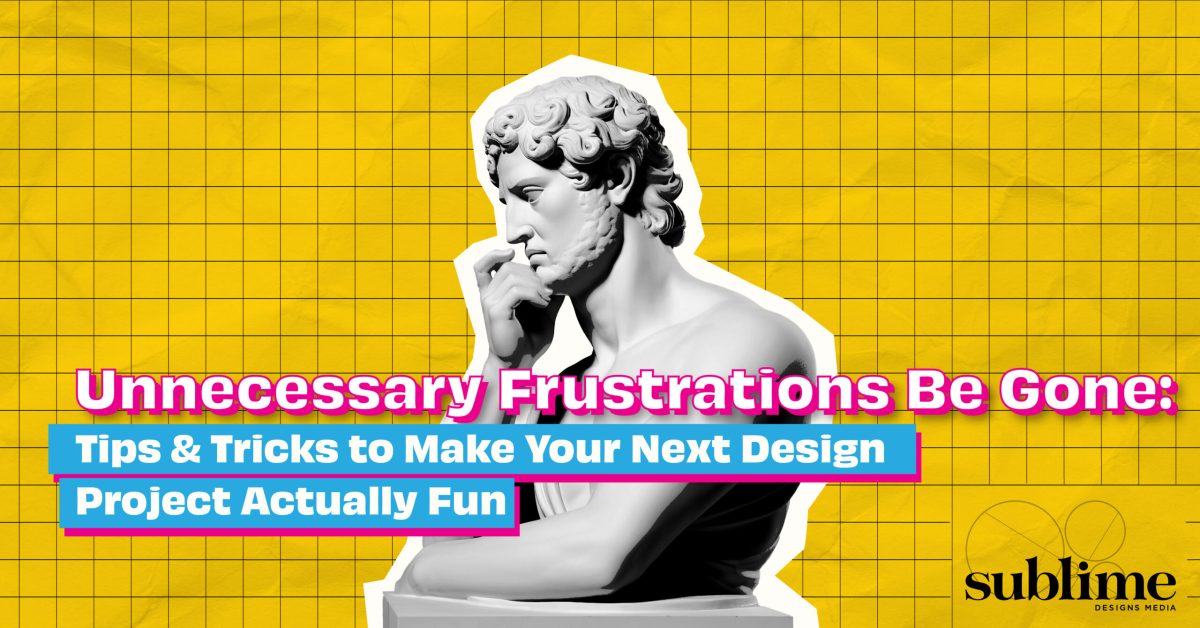Working on design projects can be downright hard. Over the years, we’ve seen where there can be a lot of confusion between designer and client and sometimes it feels as though different languages are being spoken between the two. The disconnect and miscommunication can honestly become a disorienting process that results in frustration on both sides. Which is why we’ve consistently worked to remedy this.
As the saying goes, “Practice makes perfect.” And at Sublime Designs Media, over the course of 20 years in business, we’ve had plenty of practice. In fact, we’re inclined to say that we’ve honed a process that’s pretty close to perfect.
When you’re starting any design project, whether a social graphic or a complex website, try some of these tried-and-true tips to make it a smooth, collaborative, and dare we say fun experience! Unnecessary frustrations be gone!
- A kickoff with Zoom: Back in the day, creative briefs were the name of the game. And while they certainly have value and can be effective in their own right, we prefer to kick things off with our clients with a little face time and a Zoom call. We strategically do this because we know firsthand how difficult it can be to effectively communicate a bad (or good) design without being able to see if it isn’t in front of you (this is an area creative briefs or email exchanges fall short). We will always request a Zoom call at the beginning of a working relationship, even if it’s for 10 minutes. During this time, we look at designs together and actively get on the same page so everyone is aligned and speaking the same language.
- A customer-focused approach: In order to properly craft a design that’s going to “wow” and resonate with an audience, we need to know who that audience is, which is why we’ll always ask who your target audience is. And if you’re just getting started and are unsure, or if there are differing opinions internally on who that audience may be, we also offer a persona workshop to help gain clarity on who your target audience(s) is. This information is imperative to have to create an effective design.
- A real-time review process: We’re such big fans of Zoom we honestly wish we bought stock in it before the rest of the world started relying on it. That said, when we review a design together we don’t waste anyone’s time with back and forth emails. We’ll schedule (yes, another) Zoom call to not only review the design together, but to also make changes in real time with our design programs. As we’ve noted before, communicating about design can be complicated and emails leave too much room for misinterpretations and errors. Plus, making changes and edits live as we’re discussing them makes it possible for our clients to see their requested changes in real time and evaluate what they look like in context of the design as a whole. This cuts out rounds of additional revisions, making it more efficient and easier for everyone.
- A proofing tool you’ll tell your friends about: Remember fax machines? We do. Especially since we used to have clients fax us changes they wanted made to a design we were working on, or would scan (and then email) a hard copy of paper they had printed out and written notes and edits on. The time and effort this took on both ends to make simple edits or tweaks to a design is so disturbing to think about now (and it makes us feel old). Which is why our digital proofing tool, ProofHQ is an absolute gamechanger. For projects like eBooks, reports, newsletters, magazines, brochures, or anything else that’s text-heavy, ProofHQ is an incredible tool that allows us to ask questions, track who made what change, and compile and consolidate feedback all in one place. This type of digital proofing is faster, helps reduce errors, and collaborate easier.
At the end of the day, we want our clients to be thrilled with the designs and products we create for them. And after two decades of doing this, this process is what works best for us to achieve this. With that said, we’re always looking for ways to improve and we’d love to know what’s worked for you! If you have tips or suggestions, please send them our way at [email protected]. And if you’re looking for someone to spearhead your next design project, we’d also love to hear from you!
